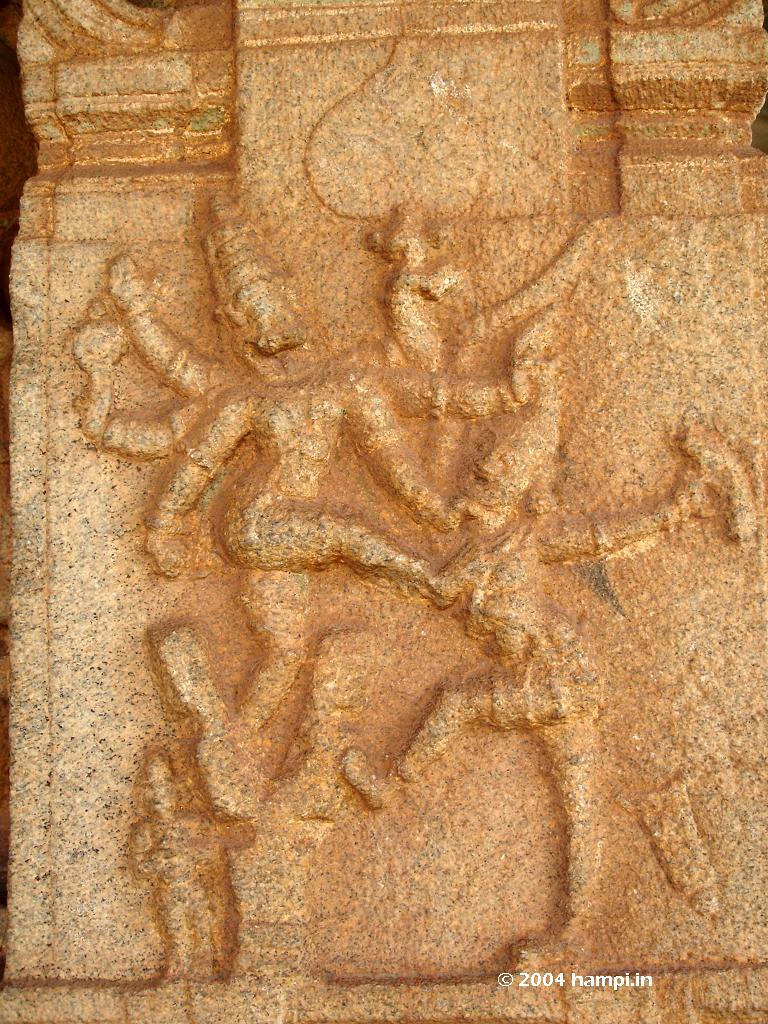Mythology of Hampi
Hindus treat Hampi as a sacred land. According to the folklore, a number of mythical events are associated with Hampi. Your understanding of what you see at Hampi would be greatly enhanced if you have some clues about the Hindu mythology and its themes.
Origin of Hampi: The name Hampi is evolved from Pampa, the ancient name of the river Tungabhadra. Also Pampa is the daughter of Brahma, the Creator God. She was a devoted worshiper of Shiva, the God of Destruction. Impressed by her dedication Shiva offered her a boon and she opted to marry him! The place thus came to be known as Pampakshetra (land of Pampa) and Shiva as Pampapathi (consort of Pampa).
T
he Hemakuta Hill in Hampi is the place, according to the myth, Shiva did his penance before marrying Pampa. Kama , the God of Love, felt sympathy for Pampa for her love towards Shiva. He disturbed Shiva from his deep meditation. That attracted Shiva’s wrath. Known for his anger, Shiva burned Kama with his third (fiery) eye. Rathi, Goddess of Passion and also Kama’s consort pleaded for mercy with Shiva. Shiva grants Kama’s life back, but only as a character and not as a physical being.On Shiva’s marriage with Pampa Gods from the heaven showered gold on the place. This hill in Hampi is called Heamakuta, literally means heap of gold.
All these places have immense religious significance for the Hindus in south India, especially the devotees of Lord Shiva. In the beginning Pampa was a local folk deity. Through the concept of a marriage with Shiva, goddess Pampa is associated into the pantheon of the Hindu gods (see Gods of Hampi).
The places mentioned here has a continuous religious history ever since known timeframe. It just happened that the Vijayanagara Empire came in-between and gone as an episode in Hampi’s long history. Even today the annual ceremonial marriage festival & the betrothal are important festivals in Hampi. With time, Shiva became more popular here as Virupaksha. Virupaksha, an incarnation of Shiva, literally means the one with oblique eye. This refers to the fact that Shiva has three eyes. The third fire eye on his forehead opens when he do the destruction.
As a tourist you can visit Virupaksha Temple (the main functioning temple in Hampi), Hemakuta hill (with about 40 temples concentrated on it), Pampa Sarovar (where Pampa did penance) and of course the river Tungabadhra.
Kishkinda Episode:
A popular folklore associates the landscape in Hampi with the Hindu epic Ramayana (see Ramayana in Hampi). The monkey kingdom, Kishkinda, is portrayed as the region around Hampi. Anjayaneya Hill, located across the river Tungabhadra, is believed to be the birth place of Hanuman.
For the Prahlada episode see the Story of Narasimha. You'll find this man-lion incarnation of Lord Vishnu icon at many sites in Hampi including the Vittala Temple and Lakshmi Narasimha Temple .
The curiously named, Bhima's Gateway located on the way to Vittala Temple from Kamalapura has a beautiful panel of Keechaka episode that happened during the exile of Pandava's. On the left is the image of Draupathi tying up her hair after Bhima slayed Duhsasana. Right image portrays Bhima killing Keechaka.
Below is the panel of Bhima with a flower bud describing the Saugandhika flower episode
In Hampi you’ll find this theme of adolescent Krishna stealing cloths of cowherd girls (Krishna on the tree with Gopis pleading with their hands folded in reverence). There is one pillar with this theme carved on one of the the slender pillars of the Kadalekalu Ganesha and another beautiful one at the Pattabhirama Temple, though a damaged due to vandalism.
Those finally end up in Hampi invariably wonder how on earth such a landscape got created! Well, you have two choices to find a solace: one in geology and the other in mythology. ( For more, see the origin of Hampi’s boulders)

Watching by the side of the fearsome Narasimha is Prahlada . Image from Vittala Temple
Watching by the side of the fearsome Narasimha is Prahlada .Image from Vittala Temple
